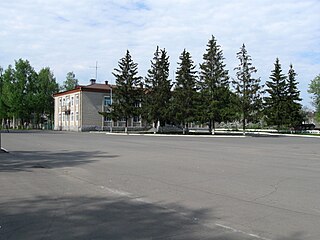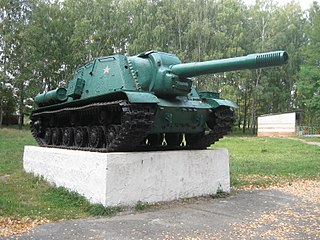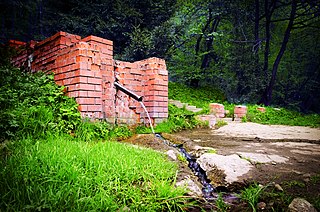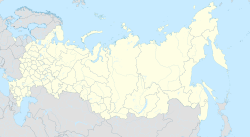
Shchigry is a town in Kursk Oblast, Russia, located between the Shchigra and Lesnaya Plata Rivers, 60 kilometers (37 mi) northeast of Kursk. Population: 14,927 (2021 Census); 17,040 (2010 Census); 19,582 (2002 Census); 21,187 (1989 Soviet census); 18,000 (1974).

Fatezh is a town and the administrative center of Fatezhsky District in Kursk Oblast, Russia, located on the Usozha River 45 kilometers (28 mi) north of Kursk, the administrative center of the oblast. Population: 4,691 (2021 Census); 5,404 (2010 Census); 5,710 (2002 Census); 5,712 (1989 Soviet census). 4,959 (1897).

Oboyan is a town and the administrative center of Oboyansky District in Kursk Oblast, Russia, located on the right bank of the Psyol at its confluence with the Oboyanka, 60 kilometers (37 mi) south of Kursk, the administrative center of the oblast. Population: 11,844 (2021 Census); 13,565 (2010 Census); 14,618 (2002 Census); 15,360 (1989 Soviet census).
Imeni Karla Libknekhta is an urban locality in Kurchatovsky District of Kursk Oblast, Russia, located on the left bank of the Seym River. Population: 7,969 (2021 Census); 7,682 (2010 Census); 8,216 (2002 Census); 9,833 (1989 Soviet census).

Konyshyovsky District is an administrative and municipal district (raion), one of the twenty-eight in Kursk Oblast, Russia. It is located in the northwestern central part of the oblast. The area of the district is 1,135 square kilometers (438 sq mi). Its administrative center is the urban locality of Konyshyovka. Population: 8,425 (2021 Census); 10,594 (2010 Census); 15,155 ; 19,234 (1989 Soviet census). The population of Konyshyovka accounts for 42.7% of the district's total population.
Korenevsky District is an administrative and municipal district (raion), one of the twenty-eight in Kursk Oblast, Russia. It is located in the southwest of the oblast. The area of the district is 873 square kilometers (337 sq mi). Its administrative center is the urban locality of Korenevo. Population: 15,018 (2021 Census); 18,294 (2010 Census); 21,474 ; 23,183 (1989 Soviet census). The population of Korenevo accounts for 37.0% of the district's total population.

Oktyabrsky District is an administrative and municipal district (raion), one of the twenty-eight in Kursk Oblast, Russia. It is located in the center of the oblast. The area of the district is 628 square kilometers (242 sq mi). Its administrative center is the urban locality of Pryamitsyno. Population: 23,164 (2021 Census); 22,569 (2010 Census); 23,877 ; 125,296 (1989 Soviet census). The population of Pryamitsyno accounts for 22.4% of the district's total population.

Ponyrovsky District is an administrative and municipal district (raion), one of the twenty-eight in Kursk Oblast, Russia. It is located in the north of the oblast. The area of the district is 690 square kilometers (270 sq mi). Its administrative center is the urban locality of Ponyri. Population: 10,893 (2021 Census); 11,778 (2010 Census); 13,553 ; 15,694 (1989 Soviet census). The population of Ponyri accounts for 45.1% of the district's total population.

Pristensky District is an administrative and municipal district (raion), one of the twenty-eight in Kursk Oblast, Russia. It is located in the south of the oblast. The area of the district is 696 square kilometers (269 sq mi). Its administrative center is the urban locality of Pristen. Population: 14,326 (2021 Census); 16,893 (2010 Census); 21,249 ; 4,935 (1989 Soviet census). The population of Pristen accounts for 34.3% of the district's total population.
Sovetsky District is an administrative and municipal district (raion), one of the twenty-eight in Kursk Oblast, Russia. It is located in the west of the oblast. The area of the district is 1,150 square kilometers (440 sq mi). Its administrative center is the urban locality of Kshensky. Population: 16,348 (2021 Census); 19,080 (2010 Census); 23,673 ; 28,252 (1989 Soviet census). The population of Kshensky accounts for 34.2% of the district's total population.
Timsky District is an administrative and municipal district (raion), one of the twenty-eight in Kursk Oblast, Russia. It is located in the east of the oblast. The area of the district is 882 square kilometers (341 sq mi). Its administrative center is the urban locality of Tim. Population: 10,208 (2021 Census); 11,759 (2010 Census); 14,628 ; 16,278 (1989 Soviet census). The population of Tim accounts for 30.0% of the district's total population.

Zheleznogorsky District is an administrative and municipal district (raion), one of the twenty-eight in Kursk Oblast, Russia. It is located in the north of the oblast. The area of the district is 991 square kilometers (383 sq mi). Its administrative center is the town of Zheleznogorsk. Population: 15,478 (2021 Census); 16,289 (2010 Census); 18,192 ; 19,571 (1989 Soviet census).

Zolotukhinsky District is an administrative and municipal district (raion), one of the twenty-eight in Kursk Oblast, Russia. It is located in the north of the oblast. The area of the district is 1,150 square kilometers (440 sq mi). Its administrative center is the urban locality of Zolotukhino. Population: 21,151 (2021 Census); 22,914 (2010 Census); 26,800 ; 31,564 (1989 Soviet census). The population of Zolotukhino accounts for 21.2% of the district's total population.

Peschanokopskoye is a rural locality and the administrative center of Peschanokopsky District in Rostov Oblast, Russia. Population: 10,593 (2010 Census); 11,357 (2002 Census); 10,966 (1989 Soviet census).
Kastornoye is an urban locality and the administrative center of Kastorensky District of Kursk Oblast, Russia. Population: 3,461 (2021 Census); 3,848 (2010 Census); 4,492 (2002 Census); 4,562 (1989 Soviet census). Telephone code: +7 47157; postal code: 306700.
Tim is an urban locality in Timsky District of Kursk Oblast, Russia. Population: 3,070 (2021 Census); 3,186 (2010 Census); 3,758 (2002 Census); 4,104 (1989 Soviet census).
Gorshechnoye is an urban locality in Gorshechensky District of Kursk Oblast, Russia. Population: 5,106 (2021 Census); 6,137 (2010 Census); 6,915 (2002 Census); 6,863 (1989 Soviet census).

Korenevo is an urban locality in Korenevsky District of Kursk Oblast, Russia. Population: 5,555 (2021 Census); 6,119 (2010 Census); 6,630 (2002 Census); 7,177 (1989 Soviet census).

Glushkovo is an urban locality in the Glushkovsky District of Kursk Oblast, Russia. In the 19th century the village was an administrative center of Glushkovskaya volost, Rylsky Uyezd, Kursk Governorate. Population: 4,785 (2021 Census); 5,349 (2010 Census); 5,748 (2002 Census); 6,413 (1989 Soviet census). The settlement is adjacent to the Seym river.
Ponyri is a rural locality in Bolshezhirovsky Selsoviet Rural Settlement, Fatezhsky District, Kursk Oblast, Russia. The population as of 2010 is 8.














